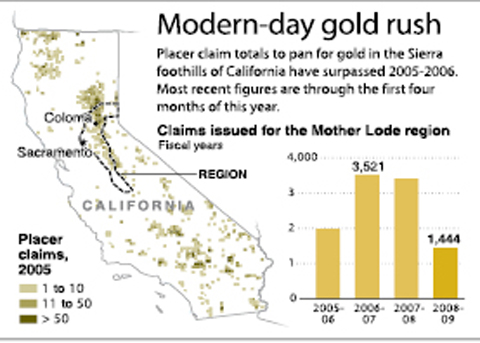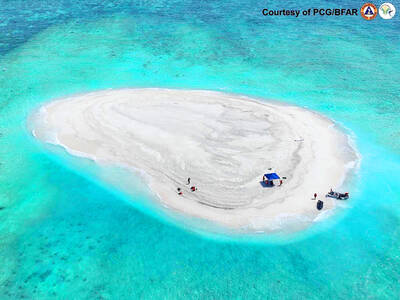There’s still gold in California’s Sierra Nevada foothills and a new rush to find it. Not since the Great Depression have so many hard-luck people been lured by prospecting, hoping to find their fortune tumbling down a mountain stream.
The recession and high gold prices are helping to fuel the latest gold craze, especially among workers who have lost jobs.
“I guess there’s always hope. At home, I don’t have any right now,” said Steve Biorck, a concrete finisher who headed west because construction work dried up in Tennessee. Now he spends days standing knee-deep in an icy creek coaxing gold flakes from a swirling pan of gravel.

Miners who locate an unclaimed area can pay a US$170 fee to the Bureau of Land Management for access to the land. Most claims are along the 200km of steep granite outcrops and rushing riverbeds that are part of California’s Mother Lode, a narrow band of gold-rich terrain.
When Don Wetter was in the Army, he guarded Fort Knox in Kentucky, home of the US Treasury’s gold depository. Now that he’s been discharged, Wetter hopes to find some gold of his own using an anticipated loan for a “grubstake,” an old mining term for money to sustain the search.
Wetter, a 22-year-old tree trimmer from Troy, Michigan, said he wanted to turn to hunt for gold because most of his customers lost their jobs or moved away.
Many would-be gold panners are drawn to the South Fork of the American River, where the 1849 discovery of nuggets at Sutter’s Mill launched the largest human migration in the Western Hemisphere. The Depression brought another wave of miners in the 1930s.
“It’s hard to keep my equipment in stock,” said Albert Fausel, the third-generation owner of the nearby Old Placerville Hardware store, which was founded to sell sluices, picks and pans to the original ’49ers.
Back then, the price of gold was US$16 an ounce. Today it hovers at about US$1,000.
The store’s wood floors used to creak under the weight of recreational rafters and fisherman. Now prospectors are some of the biggest shoppers.
“A lot of people are out of jobs and know where the gold holes are,” Fausel said.
Between October 2007 and last September, the Bureau of Land Management in California issued gold miners 3,413 permits, or claims, to search for gold on public land. That compared with 1,986 claims in 2006. So far this fiscal year, the agency has issued 1,444.
Many miners believe that only 10 percent of the gold in the Sierra Nevada was discovered in the original gold rush. They are also excited by the prospect of stumbling onto buried treasure.
“A lady was walking over there, kicked a stone with her toe and picked up a nugget just like that,” said Russ Kurz, who at 77 with a bushy white beard looks like a grizzled miner. He points to a sandbar on the American River near Coloma.
“I was walking my dog once and went to pick up a rock and pulled a long nugget straight out of the sand,” he said. “It was worth about US$6,500 — and that was 13 years ago.”
Brent Shock of Jamestown now teaches the newbies he calls “the bonanza people.” He says sandbars, cracks in bedrock and low-pressure eddies behind boulders are prime places to set up sluices, which are metal or plastic channels designed to catch gold.
Spring is the best time to hunt for gold as snow melt churns streams and rivers, potentially uncovering new riches.
“There’s got to be a lot of it sitting around somewhere,” said Eric Tring of Roseville as he panned with his 13-year-old daughter.
The gold fields are becoming so popular that Todd Osborne has had to guard a claim that has been in his family since the 1960s near a remote mountain creek.
A handmade sign with the image of a rifle and the words “private claim” dissuades most intruders, but novices often are unaware that miners can make a stake on public land.
“A couple of years ago there’d be nobody out here,” said Osborne, 41, who began prospecting full-time last year when his work as an arborist slowed.
Osborne, who says both of his grandfathers turned to prospecting during the Depression, knows the people who sold supplies to miners are the ones who stayed rich. One of the most notable examples is denim maker Levi Strauss.
Osborne owns the patent on the Bazooka Gold Trap sluice that he builds with his prospecting partner, Adam Schiffner.
The two can process up to 1,325 liters of streambed gravel a day with it, yielding between US$100 and US$1,000 in gold flakes.
They are betting that the instability of the dollar will drive gold prices even higher and entice more people to his sluice.
“Whether they get rich or not,” Osborne said, “we’ve got part of their grubstake.”

MORE VISITORS: The Tourism Administration said that it is seeing positive prospects in its efforts to expand the tourism market in North America and Europe Taiwan has been ranked as the cheapest place in the world to travel to this year, based on a list recommended by NerdWallet. The San Francisco-based personal finance company said that Taiwan topped the list of 16 nations it chose for budget travelers because US tourists do not need visas and travelers can easily have a good meal for less than US$10. A bus ride in Taipei costs just under US$0.50, while subway rides start at US$0.60, the firm said, adding that public transportation in Taiwan is easy to navigate. The firm also called Taiwan a “food lover’s paradise,” citing inexpensive breakfast stalls

PLUGGING HOLES: The amendments would bring the legislation in line with systems found in other countries such as Japan and the US, Legislator Chen Kuan-ting said Democratic Progressive Party (DPP) Legislator Chen Kuan-ting (陳冠廷) has proposed amending national security legislation amid a spate of espionage cases. Potential gaps in security vetting procedures for personnel with access to sensitive information prompted him to propose the amendments, which would introduce changes to Article 14 of the Classified National Security Information Protection Act (國家機密保護法), Chen said yesterday. The proposal, which aims to enhance interagency vetting procedures and reduce the risk of classified information leaks, would establish a comprehensive security clearance system in Taiwan, he said. The amendment would require character and loyalty checks for civil servants and intelligence personnel prior to

The China Coast Guard has seized control of a disputed reef near a major Philippine military outpost in the South China Sea, Beijing’s state media said, adding to longstanding territorial tensions with Manila. Beijing claims sovereignty over almost all of the South China Sea and has waved away competing assertions from other countries as well as an international ruling that its position has no legal basis. China and the Philippines have engaged in months of confrontations in the contested waters, and Manila is taking part in sweeping joint military drills with the US which Beijing has slammed as destabilizing. The Chinese coast guard

US PUBLICATION: The results indicated a change in attitude after a 2023 survey showed 55 percent supported full-scale war to achieve unification, the report said More than half of Chinese were against the use of force to unify with Taiwan under any circumstances, a survey conducted by the Atlanta, Georgia-based Carter Center and Emory University found. The survey results, which were released on Wednesday in a report titled “Sovereignty, Security, & US-China Relations: Chinese Public Opinion,” showed that 55.1 percent of respondents agreed or somewhat agreed that “the Taiwan problem should not be resolved using force under any circumstances,” while 24.5 percent “strongly” or “somewhat” disagreed with the statement. The results indicated a change in attitude after a survey published in “Assessing Public Support for (Non)Peaceful Unification